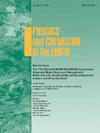Investigation of the high frequency attenuation parameter kappa (κ) beneath the volcanic region of Kyushu using surface and borehole dataset
IF 3
3区 地球科学
Q2 GEOSCIENCES, MULTIDISCIPLINARY
引用次数: 0
Abstract
This study focuses on a detailed analysis of the high-frequency attenuation parameter, kappa (κ), to better understand seismic wave propagation in the volcanic region of Kyushu. In this analysis, κ values are examined beneath the volcanic area of the Kyushu region using strong motion data from the 2016 Kumamoto earthquake. The Surface and borehole data are utilized to evaluate the effects of site conditions and regional attenuation characteristics, respectively. The site attenuation parameter (κ0) ranges from 0.022s to 0.068s, as estimated from 21 surface stations. The κ0 values correlate with average shear-wave velocity in the top 30 m (, showing a decrease as increases. Additionally, using borehole data, the region-specific S-wave quality factor (Qs) and κ0 are estimated in this region, resulting in values of 846 ± 75 and 0.050 ± 0.002s, respectively. The relatively lower Qs values and higher κ0 values observed in this study may be due to the extensive volcanic activities in the Kyushu region. The findings closely match previous studies, highlighting significant attenuation in the volcanic region. The average κ values for borehole data are 0.043s–0.053s for horizontal components (κH) and 0.038s–0.051s for vertical components (κv). Surface data shows κH values from 0.061s to 0.070s and κV from 0.039s to 0.046s. A relative comparison shows κH and κv are roughly equal in borehole conditions, while surface conditions reveal κH exceeds κv due to site effects on horizontal components. The estimated κ values are crucial for future site-specific seismic hazard analysis in Kyushu's volcanic regions.
九州火山区地表和钻孔数据高频衰减参数kappa (κ)研究
本研究重点对高频衰减参数kappa (κ)进行详细分析,以更好地了解九州火山地区地震波的传播。在本分析中,使用2016年熊本地震的强震数据检查了九州地区火山区域下方的κ值。利用地面和钻孔数据分别评估场地条件和区域衰减特征的影响。站点衰减参数(κ0)取值范围为0.022 ~ 0.068s。κ0值与上30 m平均横波速度(VS30)相关,随VS30的增大而减小。此外,利用钻孔资料估算了该区域特定s波质量因子(Qs)和κ0,分别为846±75和0.050±0.002s。本研究观测到的相对较低的Qs值和较高的κ0值可能与九州地区广泛的火山活动有关。这一发现与先前的研究结果非常吻合,强调了火山区域的显著衰减。水平分量(κ h)和垂直分量(κv)的平均κ值分别为0.043s ~ 0.053s和0.038s ~ 0.051s。地表数据表明,κH值为0.061 ~ 0.070s, κV值为0.039 ~ 0.046s。相对比较表明,钻孔条件下κH和κv大致相等,而地面条件下由于场地对水平分量的影响,κH大于κv。估计的κ值对未来九州火山地区特定地点的地震危险性分析至关重要。
本文章由计算机程序翻译,如有差异,请以英文原文为准。
求助全文
约1分钟内获得全文
求助全文
来源期刊

Physics and Chemistry of the Earth
地学-地球科学综合
CiteScore
5.40
自引率
2.70%
发文量
176
审稿时长
31.6 weeks
期刊介绍:
Physics and Chemistry of the Earth is an international interdisciplinary journal for the rapid publication of collections of refereed communications in separate thematic issues, either stemming from scientific meetings, or, especially compiled for the occasion. There is no restriction on the length of articles published in the journal. Physics and Chemistry of the Earth incorporates the separate Parts A, B and C which existed until the end of 2001.
Please note: the Editors are unable to consider submissions that are not invited or linked to a thematic issue. Please do not submit unsolicited papers.
The journal covers the following subject areas:
-Solid Earth and Geodesy:
(geology, geochemistry, tectonophysics, seismology, volcanology, palaeomagnetism and rock magnetism, electromagnetism and potential fields, marine and environmental geosciences as well as geodesy).
-Hydrology, Oceans and Atmosphere:
(hydrology and water resources research, engineering and management, oceanography and oceanic chemistry, shelf, sea, lake and river sciences, meteorology and atmospheric sciences incl. chemistry as well as climatology and glaciology).
-Solar-Terrestrial and Planetary Science:
(solar, heliospheric and solar-planetary sciences, geology, geophysics and atmospheric sciences of planets, satellites and small bodies as well as cosmochemistry and exobiology).
 求助内容:
求助内容: 应助结果提醒方式:
应助结果提醒方式:


